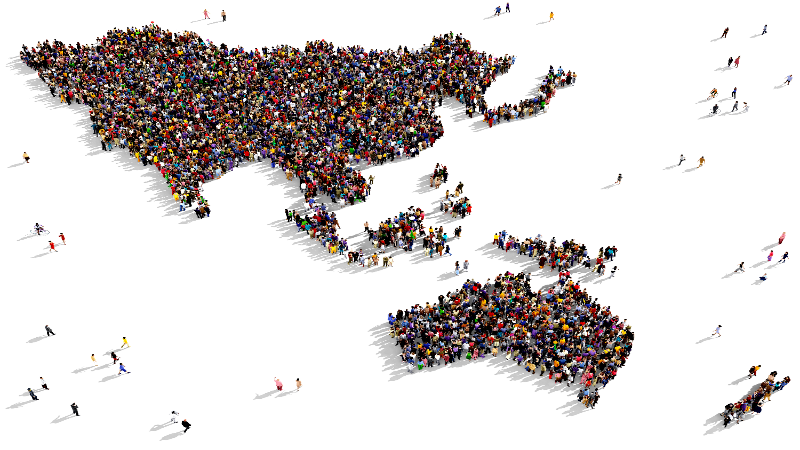AUSTRALIA-CHINA MONTHLY WRAP-UP: February 2021
March 04 2021

By Elena Collinson and James Laurenceson
The stalemate between Australia and the People’s Republic of China (PRC) lingers on: Canberra’s overtures for dialogue, steadily repeated by Prime Minister Scott Morrison and his senior ministers, continue to be rebuffed by Beijing, while Australia remains adamant that no concessions will be made in order to move forward.
Anxiety about the downward spiral of the relationship has prompted an increasing number of interventions in Australia from high-profile, well-respected figures in public service. Martin Parkinson, former head of Treasury and the Department of Prime Minister and Cabinet, this month added his voice, saying that while the Australian government is making the correct decisions in substance, the manner in which those decisions have been communicated has been an issue:
You can disentangle parts of the West and parts of the Chinese economy where there are particular sensitivities. For Australia, we’ve got to get a lot more sophisticated.
If we don't get to that situation, how do we actually manage our way through this?
Other countries in our region manage to have differences with China but keep open communication channels with China.
Prime Minister Morrison during his National Press Club address on February 1 attempted to present a somewhat clearer, franker vision of Australia-PRC relations, shifting away from the standard talking points. The Prime Minister has frequently invoked Australia’s comprehensive strategic partnership with the PRC when discussing relations between the countries. Since assuming the prime ministership, he has made it a point to continuously use this descriptor in remarks that touch on Australia’s PRC policy in both domestic and international fora, without much in the way of contextual elaboration. But in what might be the first emphatic public acknowledgement that the environment has changed since the comprehensive strategic partnership descriptor was agreed upon in 2014, and that, therefore, simply uttering the phrase no longer suffices, the Prime Minister said in his speech:
China’s outlook and the nature of China’s external engagement, both in our region and globally, has changed since our Comprehensive Strategic Partnership was formed and going further back than that, certainly in the decades that have led up till now.
We cannot pretend that things are as they were. The world has changed.
He went on to say:
An enduring partnership requires both of us to adapt to these new realities and talk with each other.
That begins with dialogue at both Ministerial and Leader level.
A dialogue focused not on concessions but on areas of mutual benefit, committed to finding a way for our nations and peoples to beneficially engage in the future.
But this proposal to get the relationship back on a civil track appears to have been again dismissed by Beijing, with state media outlet China Daily editorialising that ‘it will take more than a verbal olive branch to repair the much damaged bilateral ties.’
The PRC featured as a discussion focal point between Prime Minister Morrison and US President Joe Biden during their first phone call on February 4. While the Prime Minister tiptoed around the substance of what was discussed, telling media only that ‘we discussed regional issues in the Indo-Pacific fully’, the White House readout of the conversation was more forthright: ‘They discussed how we can work together to address global and regional challenges, including dealing with China’. The phone call took place just before President Biden’s first major foreign policy address in which he pledged to ‘take on directly the challenges posed by…our most serious competitor, China’. He said, ‘We will compete from a position of strength by…working with our allies and partners’.
On February 5 Australian journalist and former business anchor for Chinese state media outlet China Global Television Network (CGTN), Cheng Lei was formally arrested by PRC authorities after six months in detention. She was first detained on August 13 last year. Scant explanation for her arrest has been offered by the PRC, with the Australian government simply stating it had been advised that she had been arrested 'on suspicion of illegally supplying state secrets overseas'. Per Article 111 of the PRC’s criminal code, if the circumstances of the charge are ‘especially serious’ it could carry a sentence of 10 years to life imprisonment. Foreign Minister Marise Payne told ABC radio that Australia was currently 'not privy to [the] evidence' supporting Beijing’s move. She said Australia was 'seeking further advice in relation to the charges'.
Whether or not there is substantive merit to the case brought against Ms Cheng, it factors in to Beijing’s political game with Canberra. And, taken together, the detention of Ms Cheng and of Australian citizen and author Yang Hengjun, perhaps sends a message to the overseas mainland Chinese diaspora – ethnicity, not citizenship, rules above all.
Asked in a February 8 interview, ‘Should we be frightened of China?’, Prime Minister Morrison responded, ‘No, that's not the approach I take. I think we need to be constructive, aware and know what our values and to pursue them confidently.’ Yet it is clear that fear, stoked by PRC actions – its policies towards its own people and the stance it has assumed on the world stage – as well as the manner in which discussion around the PRC has been framed in Australia, has manifested itself in different ways across different sectors. For example, a Scanlon Foundation survey, released this month, tested Australian attitudes towards specific national groups. It showed that 47 percent of respondents held negative views towards Chinese-Australians. And in ‘the first decision of its kind’, five applications for Australian Research Council (ARC) grants were blocked on national security grounds by Education Minister Alan Tudge. While the Education Minister and the ARC ‘declined to identify the scientists whose applications had been rejected…they are believed to include members of the CCP’s Thousand Talents Program, and at least one with links to a top Chinese military university.’
While there have, as yet, been no dramatic economic moves against Australia by the PRC this year, the PRC steadily continues to chip away at trade sectors in which the two countries have close ties. New PRC customs data released this month also showed that more than 23,000 litres of Australian wine were stopped at PRC ports in January.
The PRC’s Ministry of Education (MoE) issued an alert on February 5, its first of 2021, exhorting students to adopt a cautious attitude towards travelling to Australia to commence or continue their studies, citing ‘a series of vicious incidents…in which students have been attacked, which poses a serious threat to the personal safety of students studying in Australia.’ A similar alert regarding studying in Australia had been issued by the PRC’s MoE on June 10 2020. While this seemed to be a largely symbolic gesture due to the fact that Australian borders continue to be closed to non-citizens and non-permanent residents due to COVID-19, it has the trappings of a more concerted effort against Australian education than that of last year, with reports emerging that education agents in the PRC are being actively encouraged by local authorities not to recommend or advertise Australian institutions to prospective students. Group of Eight chief executive Vicki Thomson said of the situation, ‘There is definitely something afoot…But we’ve had no official notification from anybody.’
The latest drive against Australian education came one day after Australia called on the PRC on February 4 ‘to allow international observers…to be given immediate, meaningful and unfettered access to Xinjiang at the earliest opportunity’, following a BBC report detailing sexual abuses suffered by Uyghur women in Xinjiang’s so-called ‘re-education’ camps. The PRC Foreign Ministry responded, ‘[W]e are firmly opposed to…the hyping-up of the so-called ‘investigation’ in Xinjiang by someone who is already convinced that we are guilty.’
Other sectors were also targeted this month, including LNG and live fish. On February 18 it was reported that tensions between Canberra and Beijing had forced Woodside Energy, Australia’s largest natural gas producer, to postpone talks to sell LNG to the PRC. Woodside’s chief executive said that potential buyers in the PRC have ‘been very clear that they won’t prioritise those LNG contracts until relations between the Australian and Chinese governments improve. The deals we are talking about – long-term LNG deals – will be held up. That’s certainly what we’re hearing back from the Chinese buyers.’
On February 25 Australia’s largest live-fish exporter and largest coral trout buyer, Australian Reef Fish Traders, failed to have its export licence renewed in the PRC. Australia’s live coral trout export trade to the PRC had faced disruption in November 2020 when the PRC’s customs authorities introduced a new testing regime purporting to test seafood for heavy metals. Despite this, Australian Reef Fish Traders had sent a record monthly consignment of 42 tonnes of live fish to the PRC in December. As such, the company said ‘it could not explain the decision to end a 20-year trading relationship.’[1]
The latest monthly data confirm the value of Australia’s goods exports to the PRC in 2020 only fell by 2.1 percent compared with 2019. This was the second largest annual value on record. Australia’s good imports from the PRC rose by 6.5 percent to hit a new historical high.
As a proportion of the Australian total, both goods exports and imports to and from the PRC reached record highs. In the case of exports, the 2020 proportion was 40.0 percent, up from 38.1 percent a year earlier. For imports, it was 28.8 percent, up from 25.8 percent.
A significant caveat with respect to exports, however, is that aggregate resilience stemmed solely from the mining sector. The value of mining exports was up by 7.6 percent on 2019. In contrast, non-mining exports fell sharply by 25.1 percent. The result was that mining occupied three-quarters (75.3 percent) of total goods exports to the PRC. This backtracked on a trend in the Australia-PRC trade relationship over the past five years towards a more diversified basket of exports sold.
Key trade indicators table - February 2021
Elena Collinson is a senior researcher at the Australia-China Relations Institute, the University of Technology Sydney.
Professor James Laurenceson is Director of the Australia-China Relations Institute at the University of Technology Sydney.
[1] For a detailed chronology of trade and investment developments in the Australia-PRC relationship, see Elena Collinson and Thomas Pantle, ‘Australia-PRC trade and investment developments: A timeline’, Australia-China Relations Institute, University of Technology Sydney <https://www.australiachinarelations.org/content/australia-prc-trade-and-investment-developments-timeline>


